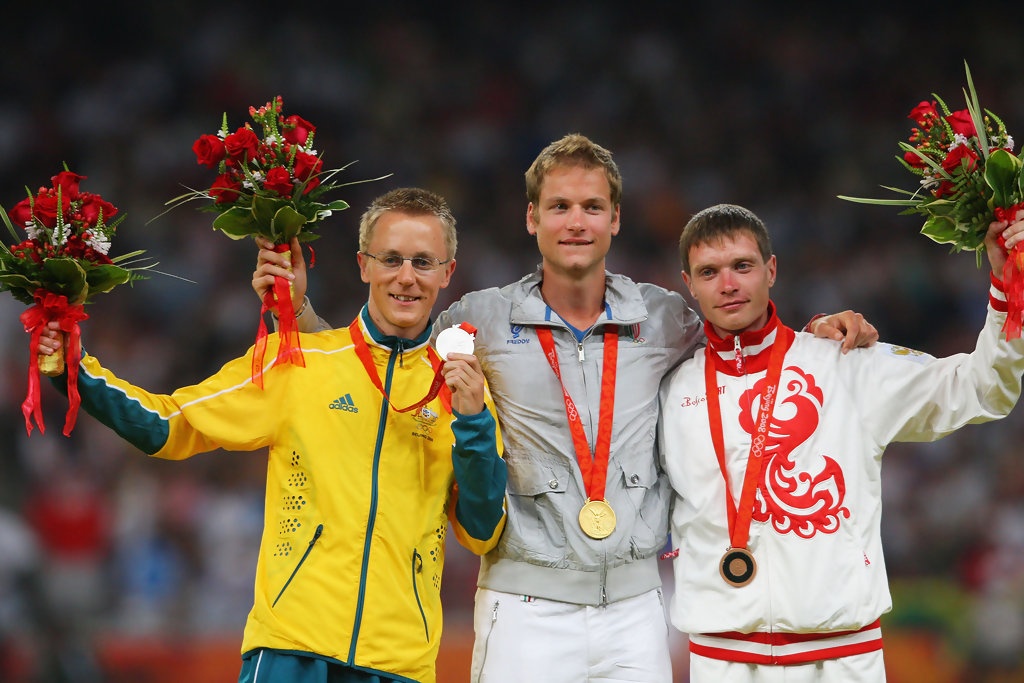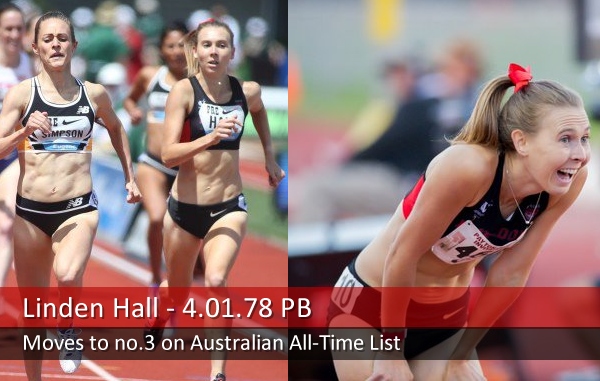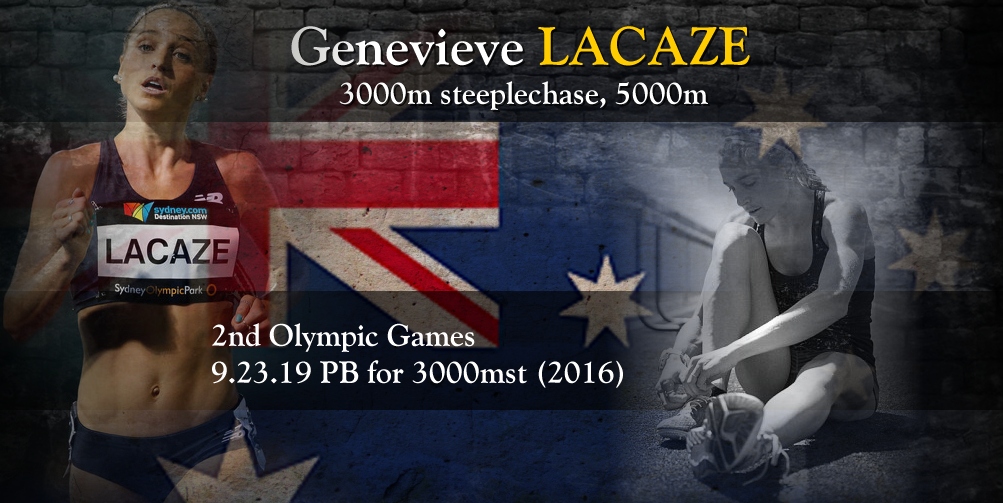The countdown is on to the start of the 2016 Rio Olympics, which will commence on August 12 (men’s discus qualification). The first final of the Olympics will take place at 12:10am (AEST) on August 13 – with the running of the women’s 10000m, featuring our very own Eloise Wellings.
Dreaming is Over – Rio is Here!
When you look back over the last 8 months it’s hard to believe how many emotional roller coasters we have experienced to arrive at this point. We started out with the excitement of seeing both Eloise Wellings and David McNeill qualifying in the 10000m at the Zatopek Classic in December, to the stunning results from the likes of Brooke Stratton, Ella Nelson and Damien Birkinhead across the domestic season. Then to see the likes of Melissa Duncan, Sally Pearson, Steve Solomon and Josh Ralph all miss out on making it to Rio, it’s sometimes hard to know what’s going to be around the corner. But in the end many of us love the sport for that one reason, expect the unexpected as individual dreams do come true and magical moments are born from the biggest stage of all – the Olympic Games.
Olympic Medal Hopes – Gold Hard to Come By
History will tell you that winning medals at Olympic Games is not an easy task, and winning gold is even harder. Since a record medal haul of 12 at the Melbourne Olympics, Australian athletes have combined to average around 3-4 medals at each Olympics, including recent gold medals from Jared Tallent and Sally Pearson in London, Steve Hooker in 2008 and the magical performance from Cathy Freeman in 2000.
This year we could see up to 6 Australians leave Rio with a medal, although we don’t actually have any gold medal favourites heading into the Games. Below we take a look at all our medal chances, with a detailed look at who their biggest competitors will be in Rio.
Jared Tallent (50km Walk)
Jared Tallent will go down in history as one of our all time greats of athletics. The only problem is that he’s been denied the glory that accompanies an Olympic champion, after receiving his 2012 Olympic gold medal 4 years after the event actually took place.
In 2016 it does look as though Tallent will compete against ‘clean’ athletes, but there is still a real possibility that one of the athletes that has been caught for drugs in the past, Italian Alex Schwazer, could still be on the start list for Rio. In a recent interview Tallent said “I would say it’s (doping investigation and Russian scandal) been a distraction, I’m not looking forward to these Olympics like I have in the past.” That’s so disappointing to hear, as Tallent has the chance to become a two time Olympic champion in the 50km walk, a rare feat that would go down in history as something so very special.
In Rio it won’t be easy for Tallent to win gold, even if Schwazer doesn’t turn up, with the likes of 2015 World Champion Matej Toth and World Record holder Yohann Diniz leading the charge. Toth is recovering from a tendon injury and has little racing in 2016, but showed his dominance in winning the World title last year. While Diniz has had a horrid run in past Olympics, with a ‘dnf’ in 2008 followed by a ‘dq’ in 2012. In saying you can’t go past the fact that he is a ‘fast’ race walker – leading the way in 2016 with a WL time of 3:37:48 back in March while also holding the WR at 3:32:33 – set back in 2014. It should also be noted that he has chosen only to compete over the 50km, not the shorter 20km event, strengthening the fact the Diniz is desperate for an elusive Olympic gold medal.
So in summary Tallent will certainly not have it all his own way, with some class walkers standing in the way of a fairy tale ending to his Olympic journey. It could indeed take one of Tallent’s best performances on the roads to produce a gold medal performance, so we can only hope that we can see the very best from Tallent even after all the controversy that surrounds this year’s games.
Final Prediction: he will come close, but maybe he’ll find just one better in Rio – albeit from a ‘clean’ athlete this time around. Silver medal
Jared Tallent’s Statistics
Major Performances over the last 12 months
- 2nd – World Team Cup, Rome ITA (3:42:36) – 8th May, 2016
- 6th – IAAF Challenge, Taicang, CHN (1:21:50, 20km) – 23rd April, 2016
- 2nd – World Championships, Beijing CHN (3:42:17) – 29th August, 2015
In the 50km walk Tallent has won Olympic gold in 2012, while also taking home silver at the 2008 Olympic Games, 2011 World Championships and 2015 World Championships. He won bronze at the 2013 World Championships in Moscow.
Talent has three times broken through the 3:40:00 barrier in his career, including his PB of 3:36:53 when winning gold in London in 2012.
Fabrice Lapierre (Long Jump)
As Fabrice Lapierre so rightly points out when asked if he can win gold in Rio – why not? It’s as simple as that, Lapierre has the ability and experience to win a gold at this years Olympic Games and we think there’s only one thing that can stop the dream becoming a reality – a big jump from one of the Americans!
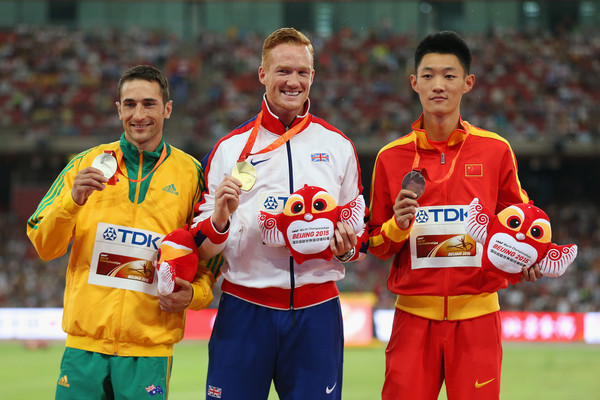
At the 2011 World Championships the ‘hot’ favourite for the long jump was our very own Mitchell Watt, only to be denied the gold by American Dwight Phillips winning his fourth world title (8.45m to 8.33m). A year later at the London Olympics Watt was again beaten into second, this time by Greg Rutherford who amazingly won gold with ‘only’ a 8.31m effort (to Watt’s 8.16m).
Rutherford will again go into Rio as the favourite to win another major title (recently winning the 2014 and 2016 European Championships, the 2015 World Championships adding to his 2012 Olympic win). There is no doubt that he should go in as favourite, but he is not a ‘big’ jumper as such. His PB stands at 8.51m from 2014, which places him at no.21 on the World All-Time ranking list.
This paves the way for the top-2 Americans, Jarrion Lawson and Jefferey Henderson, to go out and jump over 8.50m in the final and in doing so removing both Lapierre and Rutherford from the gold medal race. Lawson has the greatest ‘x-factor’, winning the 100m, 200m and long jump at this year’s NCAA Championships. He then went onto jump a ‘legal’ 8.58m at the US Trials in July – beaten only by a wind assisted 8.59m from Henderson. He also boasts a 9.90s(w) 100m performance, and is clearly the one to watch in Rio.
The third American is the 2016 World Indoor Champion in Marquis Dendy, but he has missed the finals at both the 2013 and 2015 World Championships – suggesting that he could again come unstuck when it matters most.
Outside of Rutherford and the three Americans it’s hard to see another jumper producing the required 8.30m+ jump required to win gold. Maybe Rushwal Samaai of South Africa could surprise (8.38m in 2016), but all the evidence points towards the medals being shared between the three Americans, the classy Brit and of course the no.1 Aussie long jumper – Lapierre. Maybe this will be the venue where Lapierre explodes and jumps further (legally anyway) than he has ever jumped before. Watch out for something special!
Final Prediction: Lawson could be something pretty special, with speed to burn and enough talent to produce that ‘big’ jump that will ensure the gold medal is his. I can’t believe I’m saying this but this could be Lapierre’s third silver medal in a row at a major championship (2015 World Championships + 2016 World Indoors + Rio Olympics). I really hope that I’m wrong on this one! Silver Medal
Fabrice Lapierre’s Statistics
Major Performances over the last 12 months
- 2nd – Rabat Diamond League, MAR (8.36mw) – 22nd May, 2016
- 1st – Australian Championships, Sydney, AUS (8.27m) – 3rd April, 2016
- 2nd – World Indoor Championships, Portland USA (8.25m AR) – 20th March, 2016
- 2nd – World Championships, Beijing CHN (8.24m) – 25th August, 2015
Lapierre is the 2010 World Indoor Champion, and was also 4th at the 2009 World Championships. His PB came back in 2010 when he jumped 8.40m in Nuoro, Italy. He also owns a massive jump of 8.78m (wind assisted, +3.1) when winning the National title, also in 2010.
Dani Samuels (Discus Throw)
When it comes to consistency at the highest level you could never go past our star discus thrower in Dani Samuels. Commentators on the Diamond League circuit consistently speak of how technically gifted Samuels is, and this has ensured that Samuels is always a threat at any major championship.
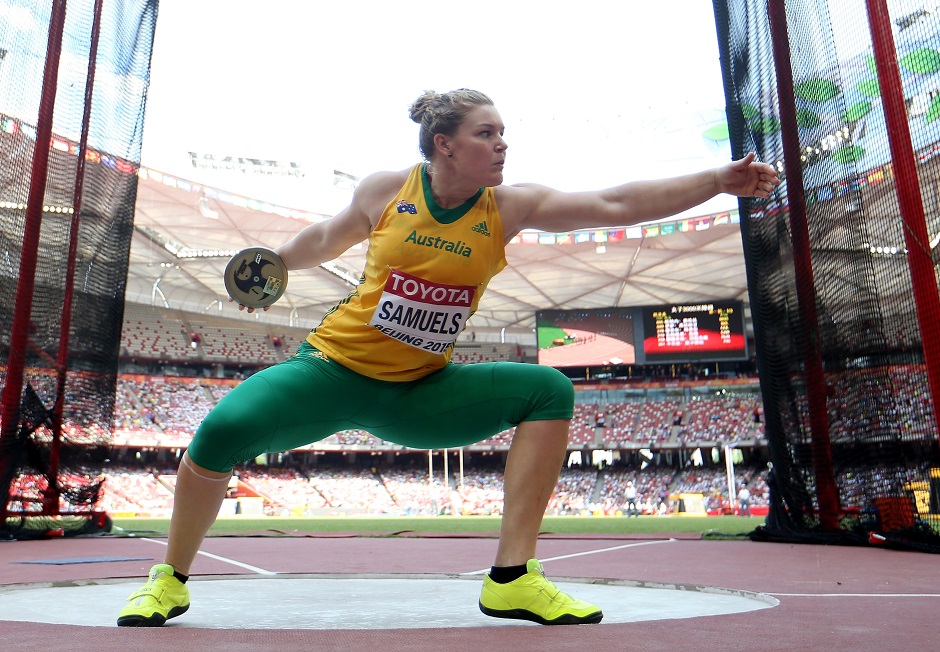
The 2009 World Champion hasn’t quite risen to the same heights over the past 5 years, but her consistency has resulted in her placing 10th, 11th, 10th and 6th at the 2011 World Championships, 2012 Olympic Games, 2013 World Championships and 2015 World Championships respectively. Therefore there is every expectation that she will again make the final in Rio, and from there anything is possible.
Her biggest opposition, and obvious favourite for gold, will definitely be Sandra Perkovic of Croatia. Perkovic has already thrown over 70m 6 times in her career, and leads the way in 2016 with a massive throw of 70.88m (just shy of her PB of 71.08m). The interesting thing to note that she wasn’t the 2015 World Champion, with that honour going to another 70m+ thrower in Cuban Denia Caballero.
At the 2015 World Championships Caballero threw 69.28m in round 1 of the final, with the pressure to respond being too much to handle for Perkovic. This is the one chink in the armour of the Croatian discus star, place some pressure on early and anything can happen.
The other big throws of 2016 have come from Cuban no.2 Yaimi Perez (68.86m) and German Julia Fischer (68.49m), while Samuels is 5th on the 2016 world list with a best of 67.77m from Shanghai back in May. These five athletes will all likely fight it out for the medals in Rio, with Samuels hoping to close in on her career best throw of 67.99m from 2014 that will surely see her right in the thick of the action from round 4 onwards in the final.
Note: in her latest competition Samuels threw an impressive 67.02m at the Sole Cup (July 29) in Germany, beaten by Fischer he threw 67.47m.
Final Prediction: There is nothing to suggest that Samuels can’t medal in Rio. 6 of her 8 competitions in 2016 has resulted in throws of over 64m, with her consistency an important part of the equation when working through who can medal in Rio. Bronze Medal
Dani Samuels’ Statistics
Major Performances over the last 12 months
- 2nd – Shanghai Diamond League, CHN (67.77m) – 14th May, 2016
- 1st – Auckland Track Challenge, NZL (66.41m) – 25th February, 2016
- 6th – World Championships, Beijing CHN (63.14m) – 25th August, 2015
Samuels took home a surprise gold medal from the 2009 World Championships, while as a junior she took the unique double – World Youth Champion in 2005 and World Junior Champion in 2006. Her PB stands at 67.99m, set back in 2014, and she has now thrown over 66.00m on 8 occasions over her career.
Dane Bird-Smith (20km Walk)
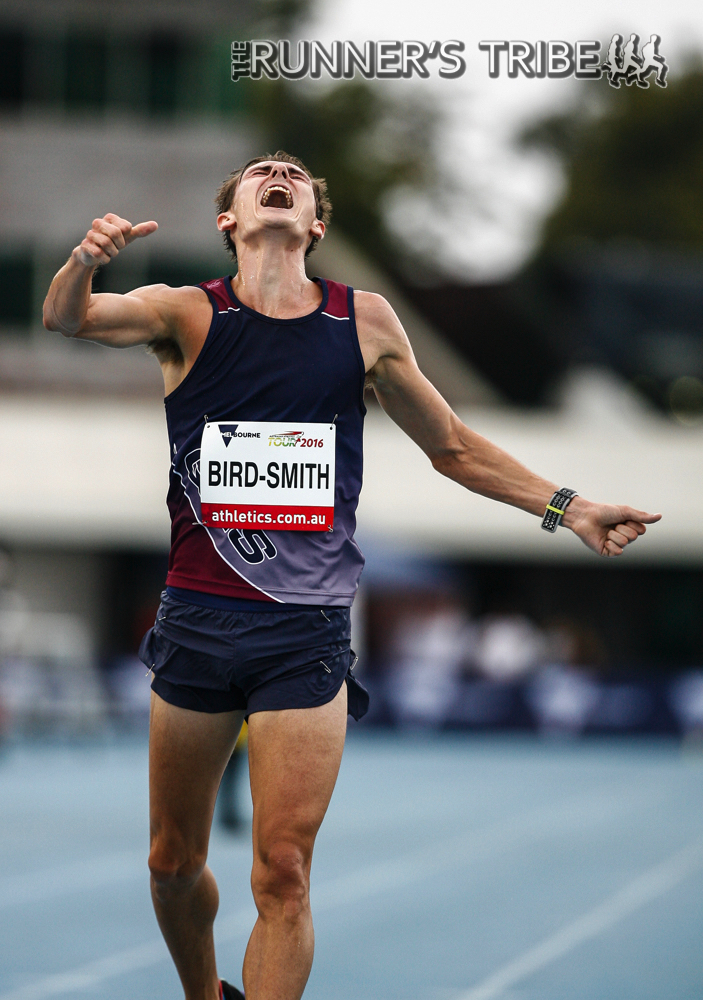
Dane Bird-Smith, a 24 year-old from Queensland who is ready to to big things in Rio. It all started for him 7 years ago when he placed 8th at the World Youth Championships, followed a year later with an excellent 5th placing at the 2010 World Junior Championships. Fast forward to 2016 and he will again be in the thick of the action when the men line up for the 20km race walk final at this years Olympic Games.
In 2016 Bird-Smith has already placed 4th at the World Team Cup event in Italy (walking a new PB of 1:19:38), following on from his first place finish at the Oceania Championships back in February, where he beat some quality walkers while also posting a fast time of 1:20:04. This was all after what was a break out year in 2015 – which saw Bird-Smith finish the year with a top-8 finish at the Beijing World Championships.
While a medal is well within reach for Bird-Smith he would definitely need to do something pretty special to walk away from Rio with the gold. The favourite for the gold will most certainly be the Chinese number 1 in Wang Zhen.
Also 24 years of age, Zhen has been a consistently high performer – which has seen him collect two World Championship silver medals (including one when he was still only 20). He’s also a ‘fast’ walker, dipping under 1:20:00 on no fewer than 15 occasions, while also breaking the Area Record with a 1:17:36 back in 2012. His dominance in the World team Cup event in May again solidifies his position as the no.1 ranked 20km walker in the world.
After Zhen the biggest challenge to Bird-Smith will come from the other power house walking nation – Japan. They have three walkers all capable of going well below 1:19:00 on their day, including Eiki Takahashi (1:18:03) and Isamu Fuijisawa (1:18:45). The interesting note to make however is that Bird-Smith was over a minute in front of Takahashi at the World Team Cup this year, so fast PB’s don’t always equate to domination at Championship level.
Final Prediction: This is the perfect opportunity for Bird-Smith to mix it with the very best in the world and not only be competative, but also show that Rio is just another stepping stone to ultimate domination in the 20km walk. Maybe this isn’t Bird-Smith’s time to win gold, but there is no doubt that he will be putting his best foot forward when the battle for the minor medals take place. Bronze Medal
Dane Bird-Smith’s Statistics
Major Performances over the last 12 months
- 4th – World Team Cup, Rome ITA (1:19:38 PB) – 7th May, 2016
- 1st – Oceania Championships, Adelaide SA (1:20:04) – 21st February, 2016
- 8th – World Championships, Beijing CHN (1:21:37) – 23rd August, 2015
In 2015 Dane Bird-Smith won gold at the World University Games against a quality field in 1:21:30. In 2013 he also placed 11th at the Moscow World Championships. At the 2010 World Junior Championships Bird-Smith finished a very creditable 5th in the 10000m race walk.
Brooke Stratton (Long Jump)
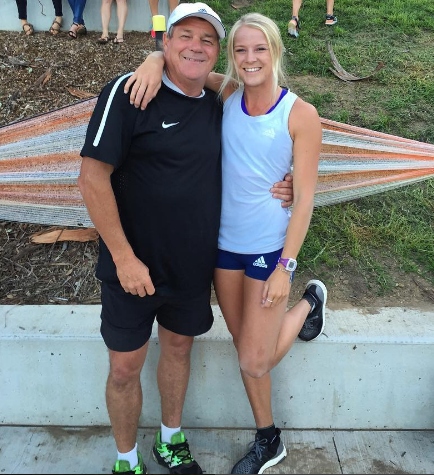
In 2015 the world didn’t really know too much about Brooke Stratton, but that has certainly changed in 2016. A 5th placing at the World Indoor Championships backed up her outstanding Australian record produced back in Perth – just 6 days prior. The 6.75m performance indoors wasn’t quite up to the 7.05m AR, but it showed just how far Stratton had come over the past 12 months.
The biggest thing that will play a pivotal part in being successful in Rio has been the consistency and quality of jumping so far in 2016. The only competitions where she hasn’t jumped over 6.60m have been at a low key meeting in early January (6.50m), where she was just starting her season, and a meeting in Switzerland where conditions were horrendous and she finished with a best of 6.36 (-1.4). Her consistency was never more evident than when she won the Perth Track Classic with her AR of 7.05m. The series read: 6.71m, 7.05m, 6.69m, 6.82m, 6.79m, 6.84m. Admittedly only two of those jumps were ‘legal’, but she showed exactly what will be required to win a medal in Rio.
The reality is that winning a medal will be something pretty special, with some very talented jumpers competing in a very competitive event. Lead by the superstar that is Brittney Reese, followed closely by the likes of Ivana Spanovic of Serbia and Tianna Bartoletta – the final of the women’s long jump in Rio will be one of the highlights of the 10 days of competition.
Reese (7.31m), Bartoletta (7.14m) and Spanovic (7.07m) have all shown that they can produce massive jumps when required. The World Indoor final was testament to this fact, with Reese and Spanovic going head to head in a fantastic competition that only saw Reese prevail with a last round effort of 7.22m (beating Spanovic’s 5th round effort of 7.07m). This will likely be the case again in Rio, although if one of them slips up then the likes of Bartoletta, Stratton or even a Shara Proctor (2015 World Championship silver medallist and 7.07m jumper) will be ready to pounce.
Final Prediction: I would think that all of Australia will be jumping on the Stratton express if she could jump over 7.00m again in Rio and claim Australia’s very first medal in the women’s long jump at an Olympic Games (Bronwyn Thompson finished 4th in Athens in 2004). There is just something telling me that again there will be three women ahead of her in Rio. It will simply push her on to bigger and better things in 2017 and beyond – and could end up being the catalyst for Olympic gold in 2020. 4th Place
Brooke Stratton’s Statistics
Major Performances over the last 12 months
- 1st – Australian Championships, Sydney NSW (6.68m) – 3rd April, 2016
- 5th – World Indoor Championships, Portland USA (6.75m) – 18th May, 2016
- 1st – Perth Track Classic, WA (7.05m AR) – 12th March, 2016
- 1st – Canberra Track Classic, ACT (6.94m) – 20th February, 2016
- 14th – World Championships, Beijing CHN (6.64m) – 27th August, 2015
Stratton was placed 6th at the World Junior Championships in 2010, and has now jumped 6.70m or above on 6 occasions over her career. Her biggest breakthrough came at the Adelaide Track Classic in 2015, where she jumped 6.73m to book her place on the Australian team for the Beijing World Championships.
Alana Boyd (Pole Vault)
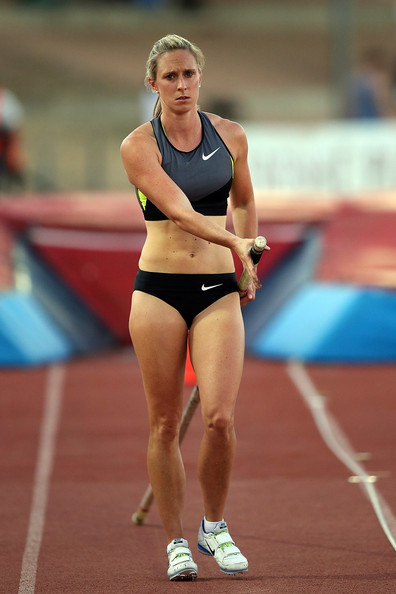
On January 14 Boyd jumped 4.71m followed two weeks later with a 4.77m Australian record. She then won the World Challenge in Melbourne, which was all a perfect lean into the 2016 World Indoor Championships. Expectations were in Portland that Boyd could come away with a medal, but she couldn’t even start the final after injuring her ankle in the warm-up.
Returning from injury Boyd again showed the world just how well she was jumping by clearing 4.55m, 4.60m followed by a 4.81m AR on July 2. She then travelled to Europe looking at taking her place at the London Diamond League, only to again aggravate her ankle in a training session just prior, and ended up bypassing the meeting.
This has been a less than ideal preparation for Rio, but what is clearly evident is that Boyd is in career best form and can clear heights that should win medals at this years Games. Her biggest rivals in Rio will be the top-2 Americans in Jenn Suhr (5.03mi in 2016), Sandi Morris (the new American outdoor record holder at 4.95m, set only recently in Houston on July 23). Then you have the two South American stars in Yarisley Silva of Cuba (4.84m in 2016) and Fabiana Murer of Brazil (4.87m in 2016). This is not to forget the most in form athlete on the European circuit (and European Champion), Ekateríni Stefanídi of Greece – who has cleared 4.90m indoors and 4.86m outdoors in 2016.
So as you can see winning medals, even without the top Russian vaulters, looks to be a tough assignment – even with Boyd being in career best form. Some experts suggest that a vault over 5.00m will be required to take home the gold will be required, and I wouldn’t disagree.
Final Prediction: If everything goes to plan and the ankle holds up, Boyd could certainly be in the mix for a medal when the bar reaches 4.80m+. The problem being is that there could easily be 5 or 6 other athletes still in the competition at this height. If a few athletes have a ‘bad’ day then maybe a medal is a possibility, but it will be tough. 6th Place
Alana Boyd’s Statistics
Major Performances over the last 12 months
- 1st – Sunshine Coast, QLD (4.81m AR) – 2nd July, 2016
- 1st – World Challenge, Melbourne VIC (4.71m) – 5th March, 2016
- 1st – Sippy Downs, QLD (4.77m) – 28th January, 2016
- 1st – Sippy Downs, QLD (4.71m) – 14th January, 2016
- 11th – World Championships, Beijing CHN (4.60m) – 26th August, 2015
Boyd placed 11th at her last Olympic Games back in 2012 (4.30m), while the Rio Olympics will be her third Olympic Games. Won gold at the 2014 Commonwealth Games (4.50m), and has now jumped over 4.70m on 5 occasions throughout her career.
Kathryn Mitchell / Kim Mickle (Javelin Throw)
Many would say that the women’s javelin at this year’s Olympic Games is the most open event across the 10 days of competition. This can only mean good news for our Aussie duo in Kathryn Mitchell and Kim Mickle in their quest to bring home a medal from Rio.
Mitchell has been a model of consistency across the Diamond League meetings in 2016, which has resulted in her being on the podium in every event she has competed in across the year. Her SB of 64.37m has her ranked at no.10 on the world lists for 2016, but if you look at the top-10 list then you would see a very even group of athletes.
Although it would be expected that a throw around 67.00m-68.00m would be required to win gold in Rio, there has yet to be a standout on the international scene in 2016 – and certainly no athlete who has dominated for an extended period of time.
The obvious favourite for gold would be 2008 and 2012 Olympic champion Barbora Špotáková of the Czech Republic, with the world record holder leading the entrants for Rio with a best in 2016 of 66.87m (June 19). Away from that performance however Spotakova has only placed 3rd in Monaco (63.34m) and was a disappointing 5th at the European Championships in early July. Last year she was only 9th at the World Championships, suggesting that her world dominance is definitely not what it was 4 years ago.
Another favourite would have been Katharina Molitor of Germany (the 2015 World Champion), except for the simple fact that she was overlooked for the Olympic Games in favour of Linda Stahl (silver at this years European Championships), Christin Hussong (66.41m in 2016) and Christina Obergfoll (2013 World Champion and a best of 64.96m in 2016). Molitor fought her exclusion from the German team for Rio, but her case was dismissed even though she finished 2nd at the German National Championships in June.
The three Germans all have a case for taking home a medal from Rio, but to pick a gold medal favourite still remains a difficult one. The surprise packet could be the 2016 European Champion in Tatsiana Khaladovich of Belerus, who threw a PB of 66.34m in Amsterdam, although the 25 year-old hasn’t really done much else in her career (ed. did manage a win in Monaco on July 15 with a best throw of 65.62m, so is throwing with some confidence).
Mitchell and Mickle will certainly think that have every chance of making the final in Rio, and after that anything is possible. Mickle is coming back from injury and recently proved her fitness with a 59.40m throw in Perth. Although this doesn’t sound like anything special, it was a big move forward for the 31 year-old Australian record holder. Mickle had previously gone into the 2015 Beijing World Championships trying to compete with a shoulder badly ripped to pieces after she had dislocated it in Germany two months prior. Since then she has been slowly returning to full fitness and will go into Rio with no real pressures that will surely be evident in many of her competitors.
Final Prediction: Even though this is an open event you would still suggest that a throw over 65.00m would be required to win a medal in Rio. With this in mind both Mitchell and Mickle will need to be throwing near their very best to make their way to the podium. The consistency shown by Mitchell in 2016 could see her push to finish better than her 5th place finish at the 2013 World Championships – and maybe this will mean that a medal is within reach. Mitchell 4th Placing, Mickle 7th Placing
Kathryn Mitchell Statistics
Major Performances over the last 12 months
- 2nd – Monaco Diamond League, MON (63.80m) – 15th July, 2016
- 2nd – Birmingham Diamond League, ENG (63.93m) – 5th June, 2016
- 1st – World Challenge, Beijing CHN (64.37m) – 18th May, 2016
- 2nd – Doha Diamond League, Doha (63.25m) – 6th May, 2016
- 1st – Melbourne World Challenge, VIC (64.37m) – 5th March, 2016
Mitchell missed out on the final at the 2015 World Championships, but did manage to place 4th at the 2014 Commonwealth Games and 5th at the 2013 World Championships. At the London Olympics Mitchell placed 9th. She has twice thrown over 66.00m – both in 2014, including a 66.10m PB in Adelaide. That throw has her placed at no.25 on the World All-Time ranking list.
Mickle’s biggest moment in athletics came at the 2013 World Championships where she took home a well deserved silver medal. The 31 year-old was also 6th at the 2011 World Championships and was the World Youth Champion back in 2001. Her PB of 66.83m was set back in March 2014, and has her ranked at no.17 on the World All-Time ranking list.
In 2015 Mickle started with impressive throws of 63.87m at the Perth Track Classic and 66.57m at the World Challenge in Melbourne, only to injure her shoulder prior to the World Championships. Time could be running out for her to be at her best in Rio, however there is never any doubt in what she will bring to the runway – determination and grit!
Next in Line: Our Other Aussie Hopes in Rio
Every Australian athlete is on their own Olympic journey, so we are not going to name every athlete in this Rio preview. What we will do is concentrate on those athletes who are in career best form and ready to produce their own magical highlights over the 10 days of competition.
- Ryan Gregson (1500m) – career best year for Gregson, which has included a 3.32.13 SB and two Diamond League podium finishes in both Rabat and Rome. He’s proven that he can mix it with the very best in 2016, and although he’s only ranked 15th on the Road to Rio list many of the athletes recorded their fastest times in 2015. Overall expect Gregson to push hard for a finals berth, and we know that anything can happen in a final (just ask Craig Mottram after the 2005 World Championships, after he collected bronze in the 5000m).
-
Linden Hall, 5th at the Prefontaine Classic in Eugene and winning in Stanford. Linden Hall (1500m) – a breakout year in which the 25 year-old has proven to the world that she’s not just going to make up the numbers in Rio. A 4.01.78 in the Eugene Diamond League event in May will ensure that Hall is full of confidence when she competes for Australia for the first time at the highest level. A recent 8th place finish at the London Diamond League (4.03.81) has only heightened expectations for Hall and her supporters, with a place on the start list for the women’s 1500m final a fitting finale to what has been an exceptional year.
- Cedric Dubler (Decathlon) – everything points to Dubler excelling in Rio, and to think that he’s still only 21 years old. The current Australian record holder, Jagan Hames, was only 22 when he broke the record with an excellent tally of 8,490 points over the 10 events. That was back in 1998, and 18 years later we again are witness to an extremely talented multi event athlete, who’s ready for big things in Rio. We think that Dubler could close in 8,4000 points in Brazil, which would surely see him break into the top-10. Currently boasting a PB of 8,114 points, Dubler’s Games could depend on how he throws the shot put, discus and javelin. These events could shape what looks set to be a very intriguing two days of competition for Dubler.
- Jess Trengove, Milly Clark, Lisa-Jane Weightman (marathon) – hard to know who will lead this trio of fine marathon runners, but essentially all have quality performances behind them heading into the Games. Weightman has the most experience behind her, and a 16th place finish at the 2012 London Games and a PB of 2:26:05 has her as a slight favourite amongst the Aussie contingent. Trengove’s big breakthrough came at the 2013 Moscow World Championships, where she worked her way through the field to place 11th, while for Clark Rio will be only her third full marathon (with her second being an incredible 2:29:07 performance last October in Amsterdam). Overall the perfect scenario would to see all three end up in the world’s top-16, while there is nothing to suggest that one or two could squeeze their way into the world’s top-10.
- Eleanor Patterson (high jump) – many experts would suggest that Patterson is a medal chance in Rio, although we’re not quite sure she can produce the heights required for such a performance. A super talented junior who has many more major championships ahead of her, Patterson would probably require something around 1.97m-1.99m to win a medal in Rio – and we think that maybe a 1.95m-1.96m effort is more likely. A 1.96m effort would equal her current PB, which is also an Australian Youth and Junior record. Last year she also placed 8th at the World Championships, a placing that could well be bettered in Rio. (ed. still only 20 years old, and still so much we have yet to see from this star jumper – so anything in Rio wouldn’t surprise us in anyway)
- Ella Nelson (200m) – this is a tricky one, with Nelson being one of the hottest athletes across the domestic season (including a PB of 22.53s), but injured herself after the Mt SAC relays in April (22.72s) and hasn’t raced since. Certainly from all accounts training has been going really well, but to have not raced for over 3 months does raise some concerns. At her best Nelson is every chance to push for a final, but that would require something close to her current PB, something only time will tell whether she can accomplish over in Rio.
- Morgan Mitchell (400m) – a 21 year-old on the rise. How can you not be impressed by a 51.25s PB – when 3rd at the Diamond League meeting in Birmingham on June 5. Mitchell has come a long way over the past 12 months, with a new coach and a new approach paying dividends as she embarks on her first Olympic Games. The most impressive part has been the fact that Mitchell has now run under 52.00s 4 times (all in 2016), with her last hit out a very solid 52.03s on the Gold Coast on July 10. Although making a final looks a step too far (likely requiring something around 50.50s), her run in Birmingham this year reminded us all that anything is possible with this talented one lap athlete, with a bright future ahead of her whatever the result in Rio.
- Madeline Hills, Genevieve LaCaze (3000m steeple) – both LaCaze and Hills have had interesting careers to date, and both are capable of big performances in Rio. LaCaze can’t stop producing PB’s in 2016 (10 so far in 2016!), with the most important statistic being the fact that she has lowered her 3000m steeple PB from 9.33.19 (2014 Glasgow Commonwealth Games) to 9.23.19 (Stockholm on June 16). This has now made her a legitimate threat in Rio for a top-10 finish, and maybe even higher. Hills has had an up and down year, with a few niggles/race falls interrupting what should have been an even better year than what has already been produced. The one big highlight for Hills came back on July 16 when she smashed her 1500m PB by over 5 seconds (4.06.47), an effort that should bring much confidence to her when she enters the Olympic village in Rio. The disappointment at missing both the 3000m steeple and 5000m final at last year’s World Championships should be quickly erased for Hills, as she pushes hard to finish in the top-10 in at least the steeple at this years Games.
- Hamish Peacock (javelin throw) – not even ranked no.1 in Australia, Peacock will still enter Rio knowing that he has raised his game over the past 6 months. Very much in line with the consistency shown by Kathryn Mitchell in the women’s javelin, Peacock has finished inside the top-5 at all of his Diamond League appearances in 2016. The highlight was when he finished 4th in Oslo, where he threw 81.86, 83.84, 79.48, 82.90, 83.47 and 84.25. An exceptional series that, if replicated, will go a long way to ensuring a top-10 finish in Rio – after missing finals at both the 2013 and 2015 World Championships.
- Matthew Denny (discus throw) – a real darkhorse, and only ranked 24 on the qualification list for Rio with his PB of 65.37m. Probably understands that a new PB would be required just to get through the qualifying rounds, Denny is definitely ready to take up the fight. All of his best throws have come in good conditions in the US, but all he needs is to keep on improving and 20 year-old could just see himself in a final at his first Olympic Games.
- Jenny Blundell (1500m) – just like Linden Hall, this year has been a break out year for the 22 year-old from NSW. A super effort at the World Challenge meeting in Beijing in May saw her smash her PB with a 4.04.62, and was quickly followed up with a 4.05.30 win in Belgium and a 11th place finish at the Stockholm Diamond League meeting on June 16 (4.07.84). These performances all suggest that her debut Olympic appearance will be more than just running around in a heat and heading back home to Australia. maybe not quite up to the standard set by Hall, but she will surprise a few people with her results in a few weeks time.
So there we have it, just a few of our stars ready to shine in Rio. There will always be the surprises, and the likes of Jeff Riseley, Peter Bol, Luke Mathews, Anneliese Rubie, Lauren Wells, Brandon Starc, Josh Robinson, Damien Birkinhead and Regan Lamble all have legitimate chances at making their own marks across the 10 days of competition.
I suppose that’s why we love the Olympic Games so much, because not everything goes to script and memorable moments are made from those surprising results. In 2012 it was the unlikely performance from Steve Solomon in the men’s 400m, eventually making the final and dipping under the magical 45 second barrier. Who will it be in 2016?
Australian Power Rankings Leading into Rio (Top-10)
[supsystic-tables id=’11’]

